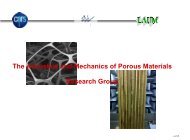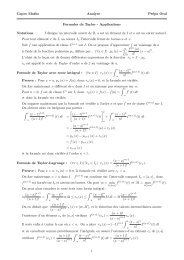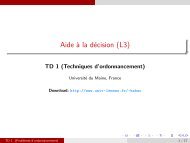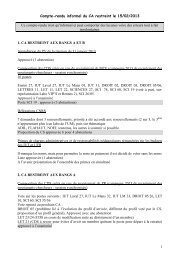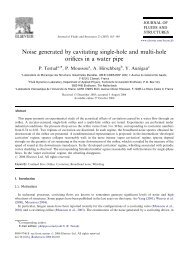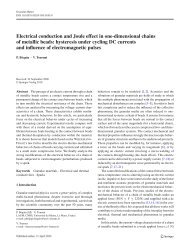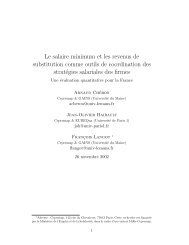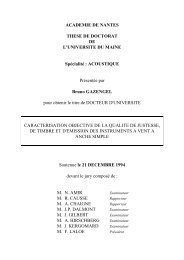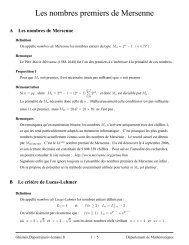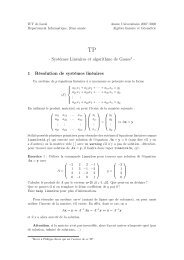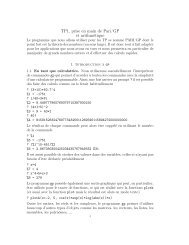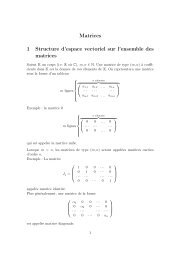Experimental demonstrations in audible frequency range of band ...
Experimental demonstrations in audible frequency range of band ...
Experimental demonstrations in audible frequency range of band ...
Create successful ePaper yourself
Turn your PDF publications into a flip-book with our unique Google optimized e-Paper software.
<strong>Experimental</strong> <strong>demonstrations</strong> <strong>in</strong> <strong>audible</strong> <strong>frequency</strong> <strong>range</strong> <strong>of</strong> <strong>band</strong><br />
gap tunability and negative refraction <strong>in</strong> two-dimensional sonic<br />
crystal<br />
Helène Pichard, a) Olivier Richoux, and Jean-Philippe Groby<br />
Laboratoire d’Acoustique de l’Universite du Ma<strong>in</strong>e, UMR-CNRS 6613, Avenue Olivier Messiaen,<br />
F-72085 Le Mans, Cedex 9, France<br />
(Received 16 November 2011; revised 2 July 2012; accepted 16 July 2012)<br />
The propagation <strong>of</strong> <strong>audible</strong> acoustic waves <strong>in</strong> two-dimensional square lattice tunable sonic crystals<br />
(SC) made <strong>of</strong> square cross-section <strong>in</strong>f<strong>in</strong>itely rigid rods embedded <strong>in</strong> air is <strong>in</strong>vestigated experimentally.<br />
The <strong>band</strong> structure is calculated with the plane wave expansion (PWE) method and compared with<br />
experimental measurements carried out on a f<strong>in</strong>ite extend structure <strong>of</strong> 200 cm width, 70 cm depth and<br />
15 cm height. The structure is made <strong>of</strong> square <strong>in</strong>clusions <strong>of</strong> 5 cm side with a periodicity <strong>of</strong> L ¼ 7.5 cm<br />
placed <strong>in</strong>between two rigid plates. The existence <strong>of</strong> tunable complete <strong>band</strong> gaps <strong>in</strong> the <strong>audible</strong><br />
<strong>frequency</strong> <strong>range</strong> is demonstrated experimentally by rotat<strong>in</strong>g the scatterers around their vertical axis.<br />
Negative refraction is then analyzed by use <strong>of</strong> the anisotropy <strong>of</strong> the equi-<strong>frequency</strong> surface (EFS) <strong>in</strong><br />
the first <strong>band</strong> and <strong>of</strong> a f<strong>in</strong>ite difference time doma<strong>in</strong> (FDTD) method. <strong>Experimental</strong> results f<strong>in</strong>ally<br />
show negative refraction <strong>in</strong> the <strong>audible</strong> <strong>frequency</strong> <strong>range</strong>. VC 2012 Acoustical Society <strong>of</strong> America.<br />
[http://dx.doi.org/10.1121/1.4744974]<br />
PACS number(s): 43.25.Jh, 43.40.Fz, 43.20.El, 43.20.Ye [ANN] Pages: 2816–2822<br />
I. INTRODUCTION<br />
Phononic crystals are periodic composite material analogue<br />
<strong>of</strong> photonic crystals for light 1 characterized by the existence<br />
<strong>of</strong> <strong>band</strong> gaps where sound, vibration and elastic wave<br />
propagation are forbidden. In the literature, various structures<br />
made <strong>of</strong> two-dimensional phononic crystals were<br />
<strong>in</strong>vestigated: acoustic <strong>band</strong> gaps <strong>in</strong> square, triangular and<br />
rectangular lattices have been found for matrix-scatterer<br />
sonic crystal either both solids or fluids, or mixed solid-fluid.<br />
The first experimental observation <strong>of</strong> <strong>band</strong> gap has been<br />
made <strong>in</strong> a 2D periodic composite structure <strong>in</strong> the ultrasonic<br />
regime. 2<br />
In order to design sound barrier, it is important to demonstrate<br />
experimentally the properties <strong>of</strong> phononic crystal <strong>in</strong> the<br />
<strong>audible</strong> <strong>frequency</strong> <strong>range</strong>. In these frequencies, phononic crystals<br />
made <strong>of</strong> circular cross-section scatterer have been studied<br />
experimentally <strong>in</strong> the case <strong>of</strong> square 3,4 and triangular 3,5 lattices,<br />
the constituent be<strong>in</strong>g mixed solid-fluid or both solid.<br />
Also, sonic crystals made <strong>of</strong> resonant scatterers, 6–9 <strong>of</strong> porous<br />
coated cyl<strong>in</strong>ders, 10,11 or <strong>of</strong> elastic shells 12,13 have been<br />
designed to lead to wide <strong>range</strong> <strong>of</strong> attenuated frequencies.<br />
Several theoretical studies po<strong>in</strong>ted out that complete<br />
phononic <strong>band</strong> gap could be enlarged by rotat<strong>in</strong>g the scatterers.<br />
14–16 Effectively, the lattice geometry (triangular, hexagonal,<br />
and square) and the scatterers shape, orientation and<br />
size, play an important role <strong>in</strong> the open<strong>in</strong>g, enlargement or<br />
shift<strong>in</strong>g <strong>of</strong> absolute acoustic <strong>band</strong> gaps. 17 By modify<strong>in</strong>g one<br />
<strong>of</strong> these parameters, it is therefore possible to tune the <strong>band</strong><br />
gaps <strong>of</strong> such ar<strong>range</strong>ment. In this way, the present paper<br />
aims to study the acoustic propagation <strong>in</strong> two dimensional<br />
sonic crystal made <strong>of</strong> square shape scatterers. In order to<br />
a) Author to whom correspondence should be addressed. Electronic mail:<br />
helene.pichard.etu@univ-lemans.fr<br />
demonstrate experimentally <strong>in</strong> the <strong>audible</strong> <strong>frequency</strong> <strong>range</strong><br />
the tunability <strong>of</strong> a such system, the <strong>band</strong> diagram <strong>of</strong> the sonic<br />
crystal is studied experimentally and theoretically for different<br />
angles <strong>of</strong> rotation <strong>of</strong> the scatterers. A first experimental<br />
study <strong>of</strong> the sound attenuation by a sonic crystal made <strong>of</strong><br />
square cross-section rods has been led 18 for a normal <strong>in</strong>cidence<br />
and one angle <strong>of</strong> rotation <strong>of</strong> the scatterers <strong>in</strong> the high<br />
<strong>frequency</strong> regime <strong>of</strong> <strong>audible</strong> sound, which po<strong>in</strong>ts out the<br />
pseudo <strong>band</strong> gap only on the CX direction. In the present paper,<br />
the acoustic attenuation <strong>of</strong> a square rods sonic crystal is<br />
<strong>in</strong>vestigated experimentally for two directions <strong>of</strong> the first<br />
Brillou<strong>in</strong> zone and for two rotation angles <strong>of</strong> the scatterers<br />
for frequencies <strong>in</strong> the speech <strong>in</strong>telligibility, i.e., between<br />
1000 Hz and 3500 Hz. The tunability <strong>of</strong> a such system is<br />
demonstrated experimentally and, <strong>in</strong> the case <strong>of</strong> a non zero<br />
angle, the existence <strong>of</strong> a complete <strong>band</strong> gap is demonstrated.<br />
Furthermore, phononic crystals exhibit other peculiar<br />
properties and <strong>in</strong> particular negative refraction <strong>of</strong> waves. In<br />
electromagnetism, the negative refraction was predicted by<br />
Veselago <strong>in</strong> 1968. 19 It has been observed <strong>in</strong> metamaterials<br />
20,21 and photonic crystals 22 <strong>in</strong> the microwave and <strong>in</strong>frared<br />
<strong>frequency</strong> <strong>range</strong>, enabl<strong>in</strong>g, for example, the design <strong>of</strong><br />
perfect lens, <strong>in</strong> which both propagat<strong>in</strong>g and evanescent<br />
waves contribute to the image reconstruction. 23 Such refraction<br />
24 as well as superlens<strong>in</strong>g effect 25 has also been observed<br />
with surface water waves <strong>in</strong> periodic structures <strong>of</strong> cyl<strong>in</strong>ders.<br />
In acoustics, most <strong>of</strong> the works related to the negative<br />
refraction is dedicated to the focus<strong>in</strong>g <strong>of</strong> ultrasonic waves. 26<br />
Acoustic superlens have been designed 27 lead<strong>in</strong>g to high resolution<br />
ultrasonic imag<strong>in</strong>g devices. Recently, experimental<br />
and numerical studies have also exhibited negative refraction<br />
for longitud<strong>in</strong>al and transversal elastic waves. 28–30 Identical<br />
phenomena have been observed for surface acoustic waves<br />
<strong>in</strong> the subgigahertz <strong>range</strong>. 31 Negative refraction <strong>of</strong> acoustic<br />
waves has ma<strong>in</strong>ly been studied numerically 32,33 and<br />
2816 J. Acoust. Soc. Am. 132 (4), Pt. 2, October 2012 0001-4966/2012/132(4)/2816/7/$30.00 VC 2012 Acoustical Society <strong>of</strong> America<br />
Author's complimentary copy
observed experimentally 34,35 <strong>in</strong> the ultrasonic <strong>frequency</strong><br />
<strong>range</strong>. Effectively, use <strong>of</strong> ultrasonic wave is the easiest way<br />
to study and observe these anomalous phenomena <strong>in</strong> spite <strong>of</strong><br />
the large visco-thermal losses <strong>in</strong> phononic crystal for these<br />
frequencies, 36 because ultrasound generation can be highly<br />
directive. To our knowledge, the negative refraction <strong>in</strong> the<br />
<strong>audible</strong> <strong>frequency</strong> <strong>range</strong> has never been demonstrated. This<br />
paper proposes a prelim<strong>in</strong>ary experimental study <strong>of</strong> the<br />
refraction <strong>in</strong> sonic crystals for <strong>audible</strong> sound and demonstrates<br />
the existence <strong>of</strong> a negative refraction <strong>in</strong> the case <strong>of</strong><br />
2D square rods crystal.<br />
To summarize, the propagation through a two-dimensional<br />
square lattice tunable crystal made <strong>of</strong> square cross-section scatterers<br />
is studied. A novel experimental set-up based on guided<br />
waves, presented <strong>in</strong> Sec. II, is used to demonstrate the tunability<br />
<strong>of</strong> this sonic crystal along two pr<strong>in</strong>cipal directions <strong>of</strong> the first<br />
Brillou<strong>in</strong> zone. To demonstrate this, experimental results<br />
obta<strong>in</strong>ed for two angles <strong>of</strong> rotation <strong>of</strong> the scatterers are compared<br />
<strong>in</strong> Sec. III. F<strong>in</strong>ally, an analysis <strong>of</strong> the equi-<strong>frequency</strong><br />
surface (EFS), confirmed by numerical results performed with<br />
f<strong>in</strong>ite difference time doma<strong>in</strong>, allows to determ<strong>in</strong>e configuration<br />
parameters to exhibit experimentally negative refraction <strong>in</strong><br />
the <strong>audible</strong> <strong>frequency</strong> <strong>range</strong> <strong>in</strong> Sec. IV.<br />
II. EXPERIMENTAL SET-UP<br />
A. The lattice sample<br />
The 2D sonic crystal (SC) is shown <strong>in</strong> Fig. 1. Inf<strong>in</strong>itely<br />
rigid square cross-section scatterers <strong>of</strong> dimensions D D<br />
h ¼ 5 5 15 cm 3 are distributed <strong>in</strong> air on a square<br />
lattice with periodicity L ¼ 7:5 cm. These scatterers are varnished<br />
wooden rods. The choice <strong>of</strong> this medium is motivated<br />
by the large impedance contrast between wood and the air<br />
FIG. 2. Schematic representation <strong>of</strong> the experimental devices.<br />
medium, which ensures that the scatterers can be considered<br />
as <strong>in</strong>f<strong>in</strong>itely rigid ones. The crystal is 192:5 65 cm 2 wide<br />
and is made <strong>of</strong> 234 scatterers ar<strong>range</strong>d <strong>in</strong> 9 layers (<strong>in</strong> the<br />
propagat<strong>in</strong>g direction, i.e., along the x axis) <strong>of</strong> 26 scatterers<br />
(<strong>in</strong> the lateral direction, i.e., along the y axis), result<strong>in</strong>g <strong>in</strong> a<br />
fill<strong>in</strong>g fraction ff ¼ D 2 =L 2 ¼ 44 %. Figure 2 presents a schematic<br />
view <strong>of</strong> the experimental device. The scatterers are<br />
placed <strong>in</strong>between two <strong>in</strong>f<strong>in</strong>itely rigid wooden plates <strong>of</strong><br />
205 70 cm 2 which formed a waveguide. The SC is centered<br />
between these two plates. The first cut-<strong>of</strong>f <strong>frequency</strong><br />
f c ¼ c=ð2hÞ <strong>of</strong> this waveguide is 1160 Hz. Above this <strong>frequency</strong>,<br />
higher modes can be excited. Nevertheless, the<br />
plane mode will ma<strong>in</strong>ly be excited because <strong>of</strong> the plane<br />
wave nature <strong>of</strong> the excitation used and described here after<br />
(Sec. II B). Therefore, the SC can be considered <strong>of</strong> <strong>in</strong>f<strong>in</strong>ite<br />
vertical extend and modeled <strong>in</strong> two dimensions. Direct sound<br />
propagation above and below the two plates <strong>of</strong> the waveguide<br />
could disturb the measurements beh<strong>in</strong>d the crystal.<br />
Two 100 cm high screens are then placed, on the source side,<br />
above and below these two plates <strong>in</strong> order to avoid such<br />
direct propagation. These two screens are perpendicular to<br />
the two plates, which form the waveguide, and are placed<br />
immediately at the entrance <strong>of</strong> the waveguide. This also enables<br />
to reduce diffraction <strong>of</strong> waves on the edges <strong>of</strong> the waveguide.<br />
The experiments are carried out <strong>in</strong> a semi-anechoic<br />
room. A cartesian coord<strong>in</strong>ate system ðx; y; zÞ is attached to<br />
the SC.<br />
The scatterers can be rotated manually around their<br />
axis. This rotation is characterized by the angle h between<br />
the scatterers sides and the lattice vectors [see Fig. 1(c)].<br />
Figures 1(a) and 1(b) depict the two configurations studied<br />
<strong>in</strong> this article: the first configuration consists <strong>in</strong> 234 scatterers,<br />
whose sides are parallel to the lattice vectors, i.e., h ¼ 0 ,<br />
and the second configuration consists <strong>in</strong> the same 234 scatterers<br />
rotated around the vertical axis <strong>of</strong> h ¼ 30 .<br />
FIG. 1. (Color onl<strong>in</strong>e) <strong>Experimental</strong> lattices, (a) h ¼ 0 and (b) h ¼ 30 ,<br />
and (c) unit cell.<br />
B. Sound source<br />
In order to generate highly directive plane waves <strong>in</strong> the <strong>audible</strong><br />
<strong>frequency</strong> <strong>range</strong>, an available parametric antenna 39 is<br />
used. This parametric antenna generates a powerful ultrasonic<br />
carrier wave at f 0 ¼ 40 kHz, which can be electronically modulatedbyanotherwaveatf<br />
0 f m ,withf m 2½200 Hz; 10 kHzŠ.<br />
Nonl<strong>in</strong>ear self-demodulation processes, dur<strong>in</strong>g the propagation<br />
<strong>of</strong> these two waves <strong>in</strong> the air, create an highly directive<br />
acoustic field beam at the modulation <strong>frequency</strong> f m . The <strong>in</strong>cident<br />
beam forms an angle a, measured counter-clockwise<br />
from the axis perpendicular <strong>of</strong> the crystal <strong>in</strong>terface, i.e., the<br />
J. Acoust. Soc. Am., Vol. 132, No. 4, Pt. 2, October 2012 Pichard et al.: <strong>Experimental</strong> study <strong>of</strong> a sonic crystal 2817<br />
Author's complimentary copy
FIG. 3. (Color onl<strong>in</strong>e) Amplitude pressure map performed <strong>in</strong> front <strong>of</strong> the<br />
parametric antenna <strong>in</strong> absence <strong>of</strong> the sonic crystal at 1600 Hz.<br />
x axis. The parametric antenna is connected to the low <strong>frequency</strong><br />
generator output <strong>of</strong> the spectrum analyzer (Stanford<br />
Research SR785).<br />
It is usually accepted that the plane wave nature <strong>of</strong> the<br />
beam is established and that the maximum <strong>of</strong> pressure amplitude<br />
is reached after a propagation distance <strong>of</strong> d s ¼ 120 cm.<br />
This distance was validated by look<strong>in</strong>g at an amplitude pressure<br />
horizontal map, presented <strong>in</strong> Fig. 3, performed <strong>in</strong> front<br />
<strong>of</strong> the parametric antenna <strong>in</strong> absence <strong>of</strong> the SC at 1600 Hz.<br />
The first <strong>in</strong>terface <strong>of</strong> the crystal is then placed at this distance.<br />
The so-created beam is 35 cm wide and 50 cm height.<br />
The height <strong>of</strong> the acoustic beam be<strong>in</strong>g larger that the crystal<br />
height, i.e., the spac<strong>in</strong>g between the two wooden plates, the<br />
field which is enter<strong>in</strong>g <strong>in</strong> the waveguide is a plane wave.<br />
This ensures that the plane mode <strong>of</strong> the guided wave is<br />
ma<strong>in</strong>ly excited. The lateral dimension <strong>of</strong> the crystal<br />
(192:5 cm) be<strong>in</strong>g larger than the width <strong>of</strong> the beam (35 cm),<br />
diffractions at the edge <strong>of</strong> the crystal are avoided.<br />
C. Data acquisition system and post-process<strong>in</strong>g<br />
Two acquisition set-up were used and are presented <strong>in</strong><br />
Fig. 2. In order to experimentally validate the <strong>band</strong> gap position<br />
and the <strong>band</strong> gap enlargement <strong>in</strong> function <strong>of</strong> h, and<br />
therefore to prove the tunability <strong>of</strong> the system, the acoustic<br />
pressure is measured beh<strong>in</strong>d the crystal, i.e., transmission<br />
measurement, by means <strong>of</strong> a 1=2 <strong>in</strong>. Bruel and Kjær microphone<br />
connected to a preamplifier and a conditioner. The<br />
microphone is placed at the end <strong>of</strong> the waveguide, i.e.,<br />
between the two plates, at 2 cm beh<strong>in</strong>d the central scatterer<br />
(see set-up 1 <strong>in</strong> Fig. 2). The excitation signal is a chirp signal<br />
between 1000 Hz and 3500 Hz. The transfer function<br />
between the so-measured transmitted acoustic pressure and<br />
the signal generator is measured by use <strong>of</strong> the spectrum<br />
analyzer.<br />
In order to po<strong>in</strong>t out the negative refraction, acoustic<br />
pressure (RMS value) vertical maps (<strong>in</strong> the y z plane) are<br />
measured by a 1=2 <strong>in</strong>. Bruel and Kjær microphone piloted<br />
by a 3D robotic system, along the x axis beh<strong>in</strong>d the SC (see<br />
set-up 2 <strong>in</strong> Fig. 2). The spatial sampl<strong>in</strong>g is 1:2 cm along the y<br />
axis and z axis. The excitation is a s<strong>in</strong>us <strong>of</strong> <strong>frequency</strong> f . The<br />
acquisition <strong>of</strong> the acoustic pressure is performed us<strong>in</strong>g a<br />
sampl<strong>in</strong>g <strong>frequency</strong> F s ¼ 10f (10 po<strong>in</strong>ts per period T ¼ 1=f )<br />
dur<strong>in</strong>g a time length T a ¼ N s =F s where N s ¼ 1000 (100 periods)<br />
is the samples number. The amplitude <strong>of</strong> the signal is<br />
determ<strong>in</strong>ed by the RMS value <strong>of</strong> the acoustic pressure.<br />
III. BAND STRUCTURE OF THE SONIC CRYSTAL<br />
The <strong>band</strong> diagram can be efficiently determ<strong>in</strong>ed by the<br />
plane wave expansion 40 (PWE) because <strong>of</strong> the high density<br />
contrast between the scatterers and the air medium. By use<br />
<strong>of</strong> theoretical models, 14,37,38 which take account for the scatterer<br />
rotation with respect to the lattice constant, the tunability<br />
effect <strong>in</strong> terms <strong>of</strong> width <strong>of</strong> the <strong>band</strong> gaps and also <strong>in</strong><br />
terms <strong>of</strong> complete <strong>band</strong> gap appearance can be exam<strong>in</strong>ed.<br />
These theoretical studies show that the width <strong>of</strong> the first<br />
<strong>band</strong> at normal <strong>in</strong>cidence <strong>in</strong>creases progressively when the<br />
rotation angle <strong>in</strong>creases for a fixed fill<strong>in</strong>g fraction. To demonstrate<br />
this effect experimentally, two angles <strong>of</strong> rotation are<br />
chosen: h ¼ 0 and h ¼ 30 . Figure 4 depicts the <strong>band</strong> diagrams<br />
<strong>of</strong> the SC calculated with the PWE for respectively<br />
h ¼ 0 and h ¼ 30 <strong>in</strong> the experimental configurations. While<br />
a <strong>band</strong> gap only exists along the CX direction for h ¼ 0 ,a<br />
complete <strong>band</strong> gap exists for h ¼ 30 . For h ¼ 30 , the<br />
ar<strong>range</strong>ment <strong>of</strong> the scatterers <strong>in</strong>duces more destructive <strong>in</strong>terferences<br />
<strong>in</strong> the SC lead<strong>in</strong>g to a complete <strong>band</strong> gap.<br />
The <strong>band</strong> diagrams calculated with the PWE method for<br />
these two specific angles h are compared with transfer function<br />
measurements performed on the f<strong>in</strong>ite size crystal as described<br />
<strong>in</strong> Sec. II. Figure 5 depicts the <strong>band</strong> diagram calculated with<br />
the PWE along the CX direction between ½1000 3500Š Hz for<br />
h ¼ 0 [Fig. 5(a)] andh ¼ 30 [Fig. 5(c)] aswellasthecorrespond<strong>in</strong>g<br />
experimental transfer function <strong>of</strong> the SC, respectively,<br />
for h ¼ 0 [Fig. 5(b)]andh ¼ 30 [Fig. 5(d)].<br />
For h ¼ 0 , two <strong>band</strong> gaps are noticed along the CX<br />
direction: the first between ½1500 2500Š Hz and the second<br />
between ½3000 3500Š Hz. These two gaps correspond to an<br />
amplitude loss <strong>of</strong> 15 dB <strong>in</strong> the measured transfer function.<br />
The measurements are <strong>in</strong> good agreement with the PWE predictions<br />
except for the second <strong>band</strong> gap: the experimental<br />
<strong>band</strong> gap is 50 to 100 Hz wider than the predicted one. This<br />
can be due to <strong>in</strong>herent disorder <strong>of</strong> the experimental handmade<br />
lattice.<br />
For h ¼ 30 , a <strong>band</strong> gap appears between ½1350 2900Š Hz<br />
as po<strong>in</strong>ted out by a decrease <strong>of</strong> 20 dB <strong>in</strong> the transfer function.<br />
This result is aga<strong>in</strong> <strong>in</strong> good agreement with the predicted one<br />
and shows an <strong>in</strong>crease <strong>of</strong> the first <strong>band</strong> gap width when compared<br />
to the previous case with h ¼ 0 . Accord<strong>in</strong>g to the<br />
FIG. 4. (Color onl<strong>in</strong>e) Band diagrams calculated with the PWE method, as<br />
shown <strong>in</strong> Refs. 14 and 37 when the lattice periodicity is L ¼ 7:5cm(ff ¼ 44 %)<br />
for h ¼ 0 (cont<strong>in</strong>uous l<strong>in</strong>e) and h ¼ 30 (dotted l<strong>in</strong>e). The colored region illustrates<br />
the complete <strong>band</strong> gap for h ¼ 30 .<br />
2818 J. Acoust. Soc. Am., Vol. 132, No. 4, Pt. 2, October 2012 Pichard et al.: <strong>Experimental</strong> study <strong>of</strong> a sonic crystal<br />
Author's complimentary copy
FIG. 6. (Color onl<strong>in</strong>e) (a) Band diagrams calculated by PWE along the MC<br />
direction with h ¼ 30 . (b) Amplitude transfer function <strong>of</strong> the SC with<br />
h ¼ 30 with oblique <strong>in</strong>cidence correspond<strong>in</strong>g to the MC direction. The gray<br />
region illustrates the <strong>band</strong> gap.<br />
FIG. 5. (Color onl<strong>in</strong>e) Band diagrams calculated by PWE along the CX<br />
direction for (a) h ¼ 0 and (c) h ¼ 30 . Transfer function <strong>of</strong> the SC for a<br />
normal <strong>in</strong>cidence for (b) h ¼ 0 and (d) h ¼ 30 . The gray regions illustrate<br />
the <strong>band</strong> gaps.<br />
<strong>of</strong> the experimental SC which can enlarge the <strong>band</strong> gap<br />
width, and to a shift <strong>of</strong> the angle <strong>of</strong> <strong>in</strong>cidence. Effectively, a<br />
small variation <strong>in</strong> the angle <strong>of</strong> <strong>in</strong>cidence can lead to important<br />
discrepancies between the experimental and the theoretical<br />
results for non normal <strong>in</strong>cidence. The oscillations that<br />
are noticed <strong>in</strong> the <strong>band</strong> gap are due to the fact that the transfer<br />
functions are calculated by measur<strong>in</strong>g the field <strong>in</strong> a po<strong>in</strong>t<br />
close to the crystal. Effectively, when the microphone is<br />
close enough to the SC, constructive <strong>in</strong>terferences that are<br />
normally trapped <strong>in</strong> the crystal can be recorded.<br />
These experimental results, obta<strong>in</strong>ed <strong>in</strong> two configurations<br />
(h ¼ 0 and h ¼ 30 ), highlight the fact that the width<br />
<strong>of</strong> the <strong>band</strong> gaps is sensitive to the rotation angle <strong>of</strong> the scatterers.<br />
The apparition <strong>of</strong> a complete <strong>band</strong> gap along the CX<br />
and CM directions <strong>in</strong> the transmission and the tunability <strong>of</strong><br />
this type <strong>of</strong> crystal are demonstrated experimentally for the<br />
first time <strong>in</strong> the speech <strong>in</strong>telligibility <strong>frequency</strong> <strong>range</strong>. This<br />
<strong>of</strong>fers the opportunity to design numerous applications for<br />
<strong>audible</strong> sound problem.<br />
PWE, a complete <strong>band</strong> gap can be obta<strong>in</strong>ed with the h ¼ 30 <br />
crystal. In order to validate the completeness <strong>of</strong> the <strong>band</strong><br />
gap, the same experiment is carried out with a ¼ 45 , which<br />
enables to experimentally <strong>in</strong>vestigate the MC direction.<br />
Figure 6 depicts the PWE prediction [Fig. 6(a)] and the<br />
experimental transfer function [Fig. 6(b)] along the MC<br />
direction for the h ¼ 30 crystal. A <strong>band</strong> gap, po<strong>in</strong>ted out by<br />
a decrease <strong>of</strong> 15 dB <strong>in</strong> the measured transfer function, is<br />
noticed experimentally between ½1900 2900Š Hz, which<br />
qualitatively corresponds to the PWE prediction. Nevertheless,<br />
this experimental <strong>band</strong> gap is wider than the predicted<br />
one. This can be expla<strong>in</strong>ed by the refraction angle between<br />
the air medium and the crystal, which is <strong>frequency</strong> dependent<br />
and make the angle <strong>of</strong> the excitation wave <strong>in</strong>side the<br />
crystal slightly different. This can also be expla<strong>in</strong>ed by the<br />
<strong>in</strong>herent disorder <strong>of</strong> the ar<strong>range</strong>ment, the f<strong>in</strong>ite dimensions<br />
IV. EXPERIMENTAL STUDY OF THE NEGATIVE<br />
REFRACTION<br />
In order to study and visualize acoustic wave refraction<br />
<strong>in</strong> the considered sonic crystal, the equi<strong>frequency</strong> surface<br />
(EFS) <strong>of</strong> the <strong>band</strong> structure is analyzed. The PWE method is<br />
used to construct the EFS contours. 41 The EFS are constructed<br />
for the acoustic waves propagat<strong>in</strong>g from air to<br />
the SC along the CX direction (<strong>in</strong> the k-space) for h ¼ 0 .<br />
Figures 7(a) and 7(b) represent, respectively, a scheme <strong>of</strong><br />
the refraction process <strong>in</strong>side the f<strong>in</strong>ite size crystal and the<br />
EFS <strong>in</strong> the SC at f ¼ 2300 Hz and for K x and K y rang<strong>in</strong>g<br />
from 0 to 1 (<strong>in</strong> units <strong>of</strong> p=a). The perfect circle is the air contour,<br />
namely x ¼ ckk air k, while the convex contour around<br />
the po<strong>in</strong>t M <strong>of</strong> the Brillou<strong>in</strong> zone is the one <strong>of</strong> the crystal. In<br />
this case, negative refraction is observed for an angle <strong>of</strong><br />
<strong>in</strong>cidence <strong>of</strong> a ¼ 25 . Indeed, the plots <strong>of</strong> the <strong>in</strong>cident wave<br />
J. Acoust. Soc. Am., Vol. 132, No. 4, Pt. 2, October 2012 Pichard et al.: <strong>Experimental</strong> study <strong>of</strong> a sonic crystal 2819<br />
Author's complimentary copy
FIG. 7. (Color onl<strong>in</strong>e) (a) Schematic <strong>of</strong> negative<br />
refraction process and (b) EFS <strong>in</strong> the k space <strong>of</strong> the<br />
air and SC at f ¼ 2300 Hz. k air and v g are the wave<br />
vector <strong>in</strong> the air and the group velocity <strong>in</strong> the SC,<br />
respectively. With a vertical conservation <strong>of</strong> <strong>frequency</strong><br />
shifted Dk, an <strong>in</strong>cident plane wave with k air<br />
will be refracted negatively.<br />
vector <strong>in</strong> the air and <strong>of</strong> the conservation <strong>of</strong> <strong>frequency</strong><br />
(dashed l<strong>in</strong>es <strong>in</strong> Fig. 7) allow to geometrically determ<strong>in</strong>e the<br />
direction <strong>of</strong> the refracted wave <strong>in</strong>side the crystal. Because <strong>of</strong><br />
the periodicity Dk ¼ p=a <strong>of</strong> the SC, the dashed l<strong>in</strong>e can be<br />
shifted at correspond<strong>in</strong>g po<strong>in</strong>ts with<strong>in</strong> the entire K space. 35<br />
The po<strong>in</strong>t where this dashed l<strong>in</strong>e <strong>in</strong>tersects the crystal contour<br />
determ<strong>in</strong>es the direction <strong>of</strong> the group velocity v g , which<br />
is toward the po<strong>in</strong>t M. The group velocity (and hence the<br />
direction <strong>of</strong> energy propagation) <strong>of</strong> sound waves <strong>in</strong>side the<br />
crystal is given by the gradient <strong>of</strong> the angular <strong>frequency</strong> with<br />
respect to the wave vector, i.e., v g ¼rxðkÞ, and is always<br />
perpendicular to the equi<strong>frequency</strong> contours. The angle <strong>of</strong><br />
refraction b is the one between the conservation <strong>of</strong> <strong>frequency</strong><br />
and v g . In this case, a wave imp<strong>in</strong>g<strong>in</strong>g the crystal with an<br />
<strong>in</strong>cident angle a ¼ 25 is refracted <strong>in</strong> the crystal with an<br />
angle b <strong>of</strong> approximately 30 . These calculations are confirmed<br />
by numerical simulations performed with a f<strong>in</strong>ite difference<br />
time doma<strong>in</strong> (FDTD) code coupled with the PML<br />
method. 42 A Gaussian beam located on the left side <strong>of</strong> the<br />
SC radiates a mono-<strong>frequency</strong> wave at f ¼ 2300 Hz. The SC<br />
is made <strong>of</strong> 6 layers <strong>of</strong> 20 scatterers width and the fill<strong>in</strong>g fraction<br />
is ff ¼ 44%. Figure 8 shows the calculated pressure<br />
field when the angle <strong>of</strong> <strong>in</strong>cidence is a ¼ 25 . The refraction<br />
angle is consistent with the one estimated from the EFS analysis<br />
and simulation result clearly demonstrates the existence<br />
<strong>of</strong> negative refraction <strong>in</strong> the <strong>audible</strong> <strong>frequency</strong> <strong>range</strong>. The<br />
negative refraction <strong>in</strong> the <strong>audible</strong> <strong>frequency</strong> <strong>range</strong> is now<br />
<strong>in</strong>vestigated experimentally. The <strong>in</strong>cident beam is adjusted<br />
<strong>in</strong> order to imp<strong>in</strong>ge the SC with an angle <strong>of</strong> <strong>in</strong>cidence <strong>of</strong><br />
a ¼ 25 <strong>in</strong> its central region, Fig. 9(a).Figure9(b) depicts vertical<br />
transmitted pressure field maps (<strong>in</strong> the y z plane) for<br />
z 2½ 0:1 : 0:1Š and y 2½ 0:5 : 0:5Š measured beh<strong>in</strong>d the<br />
crystal along the x axis for d ¼½0:1; 0:2; 0:3; 0:4; 0:5Š m.<br />
These vertical pressure maps po<strong>in</strong>t out the existence <strong>of</strong> a<br />
FIG. 8. (Color onl<strong>in</strong>e) FDTD simulation <strong>of</strong> refraction <strong>in</strong> a square rod sonic<br />
crystal for f ¼ 2300 Hz and with an <strong>in</strong>cident angle a ¼ 25 .<br />
FIG. 9. (Color onl<strong>in</strong>e) (a) Scheme <strong>of</strong> the experimental device. (b) Vertical<br />
amplitude pressure maps from d ¼ 0:1 m (top) to d ¼ 0:5 m (low) beh<strong>in</strong>d<br />
the sonic crystal. The same color scale is used for all the maps.<br />
2820 J. Acoust. Soc. Am., Vol. 132, No. 4, Pt. 2, October 2012 Pichard et al.: <strong>Experimental</strong> study <strong>of</strong> a sonic crystal<br />
Author's complimentary copy
FIG. 10. (Color onl<strong>in</strong>e) Average value along the z axis <strong>of</strong> the squared pressure<br />
modulus <strong>in</strong> function <strong>of</strong> y for d ¼½0:1; 0:2; 0:3; 0:4; 0:5Š m and for<br />
z 2½ 0:1 : 0:1Š. The <strong>in</strong>sert shows the positions () along the y axis <strong>of</strong> the<br />
weighted mean <strong>of</strong> p 2 ðzÞ for each value <strong>of</strong> z 2½ 0:1 : 0:1Š and for<br />
d ¼½0:1; 0:2; 0:3; 0:4; 0:5Š m. The vertical l<strong>in</strong>es give the variance <strong>of</strong> the<br />
distribution. The dashed l<strong>in</strong>es shows the position <strong>of</strong> hp 2 ðzÞi estimated with<br />
FDTD.<br />
transmitted acoustic beam propagat<strong>in</strong>g from the center <strong>of</strong> the<br />
crystal towards a preferential direction <strong>in</strong> the half-space<br />
def<strong>in</strong>ed by y > 0. We noticed that an acoustic beam for <strong>audible</strong><br />
<strong>frequency</strong> <strong>range</strong> can not be as well def<strong>in</strong>ed as <strong>in</strong> the case<br />
<strong>of</strong> ultrasonic waves. It is remarkable to obta<strong>in</strong> a transmitted<br />
acoustic beam for this <strong>frequency</strong> <strong>range</strong> without the selfmodulation<br />
process. Effectively, the nonl<strong>in</strong>ear effect <strong>of</strong> the<br />
parametric source can not stand at this distance. The beam is<br />
not spread <strong>in</strong>side the SC and the angle <strong>of</strong> the transmitted<br />
beam is approximately a. The negative refraction is noticed<br />
because the y coord<strong>in</strong>ate <strong>of</strong> the transmitted beam center at<br />
the exit <strong>of</strong> the SC is lower than the y coord<strong>in</strong>ate <strong>of</strong> the <strong>in</strong>cident<br />
beam center at the entrance <strong>of</strong> the SC. If the refraction<br />
would have stand <strong>in</strong> a regular way, the position <strong>of</strong> the <strong>in</strong>cident<br />
center beam would have been located for y > 0.<br />
To study the refraction angle <strong>of</strong> the transmitted beam,<br />
the average value <strong>of</strong> the squared pressure modulus along the<br />
z axis for each value <strong>of</strong> d (d ¼½0:1; 0:2; 0:3; 0:4; 0:5Š m) is<br />
performed. The results are shown on the Fig. 10. The negative<br />
refraction is clearly highlighted by the distribution <strong>of</strong><br />
the acoustic <strong>in</strong>tensity along the y axis <strong>in</strong> function <strong>of</strong> d: the<br />
transmitted beam center is located around y ¼ 0 for d ¼ 0:1<br />
and moves to y > 0 when d is <strong>in</strong>creased. To re<strong>in</strong>force this<br />
result, the weighted mean <strong>of</strong> squared pressure modulus p 2<br />
along y for each value <strong>of</strong> z 2½ 0:1 : 0:1Š (each horizontal<br />
l<strong>in</strong>e <strong>of</strong> the pressure maps <strong>in</strong> Fig. 9) and for each distance d<br />
are presented <strong>in</strong> the <strong>in</strong>sert <strong>of</strong> the Fig. 10. The standard deviations<br />
r d <strong>of</strong> the distributions are illustrated by the vertical segments<br />
with length 2r d . The dashed l<strong>in</strong>e shows the position <strong>of</strong><br />
the weighted mean <strong>of</strong> the squared pressure modulus estimated<br />
with a FDTD method performed with the same characteristics<br />
as the experimental study (9 rows and 26 l<strong>in</strong>es).<br />
The distribution <strong>of</strong> the weighted mean <strong>of</strong> squared pressure<br />
modulus is qualitatively <strong>in</strong> agreement with the attempted<br />
result. Due to the nearfield radiations <strong>in</strong>fluence, the position<br />
<strong>of</strong> the weighted mean po<strong>in</strong>ts for the first map (where<br />
d ¼ 0:1 m is smaller than the wavelength) is underevaluated.<br />
In the same way, the position <strong>of</strong> the weighted mean po<strong>in</strong>ts for<br />
d ¼ 0:5 m is also underevaluated because the <strong>in</strong>vestigated<br />
area is too narrow: one part <strong>of</strong> the acoustic <strong>in</strong>tensity <strong>of</strong> the<br />
beam is localized to y def<strong>in</strong>ed by y > 0:5 which allows to an<br />
underevaluation <strong>of</strong> the position. On the contrary, the weighted<br />
mean positions for d ¼½0:2; 0:3; 0:4Š m are <strong>in</strong> agreement<br />
with the simulated results. The extended distribution <strong>of</strong> the<br />
weighted mean positions, illustrated by the errorbars on the<br />
curve, can be caused by the <strong>in</strong>herent disorder <strong>of</strong> the scatterers<br />
distribution and also by the error on the <strong>in</strong>cident beam angle.<br />
Moreover, the change <strong>of</strong> impedance between the conf<strong>in</strong>ed<br />
area <strong>of</strong> the crystal and the free field beh<strong>in</strong>d the crystal can<br />
expla<strong>in</strong> the relative dispersion <strong>of</strong> the acoustic beam beh<strong>in</strong>d<br />
the crystal. But, <strong>in</strong> spite <strong>of</strong> these experimental difficulties<br />
related to the <strong>audible</strong> <strong>frequency</strong> <strong>range</strong>, this prelim<strong>in</strong>ary study<br />
po<strong>in</strong>ts out the existence <strong>of</strong> negative refraction for acoustic<br />
waves <strong>in</strong> the <strong>audible</strong> <strong>frequency</strong> <strong>range</strong>.<br />
V. CONCLUSION AND PERSPECTIVES<br />
The acoustic <strong>band</strong> structure <strong>of</strong> a 2D sonic crystal made<br />
up <strong>of</strong> square cross-section scatterers embedded <strong>in</strong> air on a<br />
square lattice is <strong>in</strong>vestigated. The existence <strong>of</strong> tunable <strong>band</strong><br />
gaps <strong>in</strong> the <strong>audible</strong> <strong>frequency</strong> <strong>range</strong> are proved experimentally.<br />
This confirms the <strong>in</strong>fluence <strong>of</strong> the scatterer rotation <strong>in</strong><br />
the unit cell on the <strong>band</strong> gap width and appearance and demonstrates<br />
the efficiency <strong>of</strong> this type <strong>of</strong> SC as tunable crystal<br />
<strong>in</strong> the <strong>audible</strong> <strong>frequency</strong> <strong>range</strong>.<br />
Negative refraction is studied through the equi<strong>frequency</strong><br />
surfaces analysis and FDTD simulation. It is found that such<br />
anomalous refraction can happen with scatterer side parallel<br />
to the lattice vector, i.e., h ¼ 0 , for an <strong>in</strong>cident wave <strong>of</strong><br />
2300 Hz at a ¼ 25 . Negative refraction is demonstrated<br />
experimentally by means <strong>of</strong> 2D vertical maps <strong>of</strong> the transmitted<br />
wave field through the crystal.<br />
A sonic crystal made <strong>of</strong> square cross-section long rods<br />
with an automatic system enabl<strong>in</strong>g the control <strong>of</strong> the angle<br />
<strong>of</strong> rotation <strong>of</strong> the scatterer is currently under fabrication.<br />
This structure will allow us to study more precisely the tunable<br />
effect and negative refraction for different angles <strong>of</strong> rotation<br />
<strong>of</strong> the scatterers experimentally.<br />
ACKNOWLEDGMENTS<br />
The autors wish to thank Bastien Breteau and Miguel<br />
Moleron for their help dur<strong>in</strong>g the experiments and Clement<br />
Lagarrigue and Benoit Nenn<strong>in</strong>g for their constructive remarks.<br />
1 E. P. Yablonovitch and T. J. Gmitter, “Photonic <strong>band</strong> structure: The face<br />
centered cubic case,” Phys. Rev. Lett. 63, 1950–1953 (1989).<br />
2 F. R. Montero de Esp<strong>in</strong>osa, E. Jimenez, and M. Torres, “Ultrasonic <strong>band</strong><br />
gap <strong>in</strong> a periodic two-dimensional composite,” Phys. Rev. Lett. 80, 1208–<br />
1211 (1998).<br />
3 V. G. Sanchez-Perez, D. Caballero, R. Mart<strong>in</strong>ez-Sala, C. Rubio, J. Sanchez-<br />
Dehesa, F. Meseguer, J. Ll<strong>in</strong>ares, and F. Galvez, “Sound attenuation by a<br />
two-dimensional array <strong>of</strong> rigid cyl<strong>in</strong>ders,” Phys. Rev. Lett. 80, 5325–5328<br />
(1998).<br />
4 J. O. Vasseur, A. Khelif, P. A. Deymier, Ph. Lamb<strong>in</strong>, B. Djafari-Rouhani,<br />
A. Akjouj, L. Dobrzynski, N. Fettouhi, and J. Zemmouri, “Phononic crystal<br />
with low fill<strong>in</strong>g fraction and absolute acoustic <strong>band</strong> gap <strong>in</strong> the <strong>audible</strong><br />
<strong>frequency</strong> <strong>range</strong>: A theoretical and experimental study,” Phys. Rev. E 65,<br />
056608 (2002).<br />
J. Acoust. Soc. Am., Vol. 132, No. 4, Pt. 2, October 2012 Pichard et al.: <strong>Experimental</strong> study <strong>of</strong> a sonic crystal 2821<br />
Author's complimentary copy
5 J. O. Vasseur, P. A. Deymier, B. Chenni, B. Djafari-Rouhani, L. Dobrzynski,<br />
and D. Prevost, “<strong>Experimental</strong> and theoretical evidence for the<br />
existence <strong>of</strong> absolute acoustic <strong>band</strong> gaps <strong>in</strong> two-dimensional solid phononic<br />
crystals,” Phys. Rev. Lett 86, 3012–3015 (2001).<br />
6 E. Fuster-Garcia, V. Romero-Garcia, J. Sanchez-Perez, and L. Garcia-<br />
Raffi, “Targeted <strong>band</strong> gap creation us<strong>in</strong>g mixed sonic crystals arrays<br />
<strong>in</strong>clud<strong>in</strong>g resonators and rigid scatterers,” Appl. Phys. Lett. 90, 244104<br />
(2007).<br />
7 V. Romero-Garcia, J. Sanchez-Perez, and L. Garcia-Raffi, “Tunable wide<strong>band</strong><br />
<strong>band</strong>stop acoustic filter based on two-dimensional multiphysical phenomena<br />
periodic systems,” J. Appl. Phys. 110, 014904 (2009).<br />
8 D. P. Elford, L. Chalmers, F. V. Kusmartsev, and G. M. Swallowe,<br />
“Matryoshka locally resonant sonic crystal,” J. Acoust. Soc. Am. 130,<br />
2746–2755 (2011).<br />
9 V. Romero-Garcia, J. Sanchez-Perez, L. Garcia-Raffi, J. Herrero, S. Garcia-Nieto,<br />
and X. Blasco, “Hole distribution <strong>in</strong> phononic crystals: Design<br />
and optimization,” J. Acoust. Soc. Am. 125, 3774 (2009).<br />
10 O. Umnova, K. Attenborough, and C. L<strong>in</strong>ton, “Effects <strong>of</strong> porous cover<strong>in</strong>g<br />
on sound attenuation by periodic arrays <strong>of</strong> cyl<strong>in</strong>ders,” J. Acoust. Soc. Am.<br />
119, 278–284 (2006).<br />
11 J. Sanchez-Dehesa, V. M. Garcia-Chocano, D. Torrent, F. Cervera, S.<br />
Cabrera, and F. Simon, “Noise control by sonic crystal barriers made <strong>of</strong><br />
recycled materials,” J. Acoust. Soc. Am. 129, 1173–1183 (2011).<br />
12 Y. A. Kosevich, C. G<strong>of</strong>faux, and J. Sanchez-Dehesa, “Fano-like resonance<br />
phenomena by flexural shell modes <strong>in</strong> sound transmission through twodimensional<br />
periodic arrays <strong>of</strong> th<strong>in</strong>-walled hollow cyl<strong>in</strong>ders,” Phys. Rev.<br />
B 74, 012301 (2006).<br />
13 A. Krynk<strong>in</strong>, O. Umnova, A. Y. B. Chong, S. Taherzadeh, and K. Attenborough,<br />
“Predictions and measurements <strong>of</strong> sound transmission through a periodic<br />
array <strong>of</strong> elastic shells <strong>in</strong> air,” J. Acoust. Soc. Am. 128, 3496–3506<br />
(2010).<br />
14 C. G<strong>of</strong>faux and J. P. Vigneron “Theoretical study <strong>of</strong> a tunable phononic<br />
<strong>band</strong> gap system,” Phys. Rev. B 64, 075118 (2001).<br />
15 W. Kuang, Z. Hou, and Y. Liu, “The effects <strong>of</strong> shapes and symmetries <strong>of</strong><br />
scatteres on the phononic <strong>band</strong> gap <strong>in</strong> 2D phononic crystal,” Phys. Rev.<br />
Lett. A 332, 481–490 (2004).<br />
16 Y. Z. Wang, F. M. Li, and W. H. Wang, “Effects <strong>of</strong> <strong>in</strong>clusion shapes on<br />
the <strong>band</strong> gaps <strong>in</strong> two-dimensional piezoelectric phononic crystals,” J.<br />
Phys. Condens. Matter 19, 496204 (2007).<br />
17 D. Caballero, J. Sanchez-Dehesa, R. Mart<strong>in</strong>ez-Sala, J. V. Sanchez-Perez,<br />
F. Meseguer, and J. Ll<strong>in</strong>ares, “Large two-dimensional sonic <strong>band</strong> gaps,”<br />
Phys. Rev. E 60, R6316–R6319 (1999).<br />
18 C. G<strong>of</strong>faux, F. Maseri, J. O. Vasseur, B. Djafari-Rouhani, and Ph. Lamb<strong>in</strong>,<br />
“Measurements and calculations <strong>of</strong> the sound attenuation by a phononic<br />
<strong>band</strong> gap structure suitable for an <strong>in</strong>sulat<strong>in</strong>g partition application,” Appl.<br />
Phys. Lett. 83, 281–284 (2003).<br />
19 V. Veselago, “The electrodynamics <strong>of</strong> substances with simultaneously<br />
negative values <strong>of</strong> and l,” Sov. Phys. Usp. 10, 510–514 (1968).<br />
20 J. B. Pendry, “Extremely low <strong>frequency</strong> plasmons <strong>in</strong> metallic microstructures,”<br />
Phys. Rev. Lett. 76, 4773–4785 (1996).<br />
21 J. B. Pendry, A. J. Holden, D. J. Robb<strong>in</strong>s, and W. J. Stewart, “Low <strong>frequency</strong><br />
plasmons <strong>in</strong> th<strong>in</strong>-wire structures,” J. Phys. Condens. Matter 10,<br />
4785 (1998).<br />
22 M. Notomi, “Theory <strong>of</strong> light propagation <strong>in</strong> strongly modulated photonic<br />
crystals: Refractionlike behavior <strong>in</strong> the vic<strong>in</strong>ity <strong>of</strong> the photonic <strong>band</strong> gap,”<br />
Phys. Rev. B 62, 10696–10705 (2000).<br />
23 C. Luo, S. G. Johnson, J. D. Joannopoulos, and J. B. Pendry, “Subwavelength<br />
imag<strong>in</strong>g <strong>in</strong> photonic crystals,” Phys. Rev. B 68, 045115 (2003).<br />
24 X. Hu, Y. Shen, X. Liu, R. Fu, and J. Zi, “Complete <strong>band</strong> gaps for liquid<br />
surface waves propagat<strong>in</strong>g over a periodically drilled bottom,” Phys. Rev.<br />
E 68, 066308 (2003).<br />
25 X. Hu, Y. Shen, X. Liu, R. Fu, and J. Zi, “Superlens<strong>in</strong>g effect <strong>in</strong> liquid surface<br />
waves,” Phys. Rev. E 69, 030201 (2004).<br />
26 A. Sukhovich, L. J<strong>in</strong>g, and J. H. Page, “Negative refraction and focus<strong>in</strong>g<br />
<strong>of</strong> ultrasound <strong>in</strong> two-dimensional phononic crystals,” Phys. Rev. B 77,<br />
014301 (2008).<br />
27 S. Zhang, L. Y<strong>in</strong>, and N. Fang, “Focus<strong>in</strong>g ultrasound with an acoustic<br />
metamaterial network,” Phys. Rev. Lett. 102, 194301 (2009).<br />
28 C. Croenne, E. Manga, B. Morvan, A. T<strong>in</strong>el, B. Dubus, J. Vasseur, and A.<br />
Hladky-Hennion, “Negative refraction <strong>of</strong> longitud<strong>in</strong>al waves <strong>in</strong> a twodimensional<br />
solid-solid phononic crystal,” Phys. Rev. B 83, 054301<br />
(2011).<br />
29 A. Hladky-Hennion, C. Croenne, B. Dubus, J. Vasseur, L. Haumesser, D.<br />
Manga, and B. Morvan, “Negative refraction <strong>of</strong> elastic waves <strong>in</strong> a 2D phononic<br />
crystal: Contribution <strong>of</strong> resonant transmissions to the construction<br />
<strong>of</strong> the image <strong>of</strong> a po<strong>in</strong>t source,” AIP Adv. 1, 041405 (2011).<br />
30 B. Morvan, A. T<strong>in</strong>el, A. Hladky-Hennion, J. Vasseur, and B. Dubus,<br />
“<strong>Experimental</strong> demonstration <strong>of</strong> the negative refraction <strong>of</strong> a transverse<br />
elastic wave <strong>in</strong> a two-dimensional solid phononic crystal,” Appl. Phys.<br />
Lett. 96, 101905 (2010).<br />
31 B. Bonello, L. Belliard, J. Pierre, J. O. Vasseur, B. Perr<strong>in</strong>, and O. Boyko,<br />
“Negative refraction <strong>of</strong> surface acoustic waves <strong>in</strong> the subgigahertz <strong>range</strong>,”<br />
Phys. Rev. B 82, 104109 (2010).<br />
32 S. Feng, Z.-Y. Li, Z.-F. Feng, K. Ren, B.-Y. Cheng, and D.-Z. Zhang,<br />
“Focus<strong>in</strong>g properties <strong>of</strong> a rectangular-rod photonic-crystal slab,” J. Appl.<br />
Phys. 98, 063102 (2005).<br />
33 Y. Huang, W. Lu, and S. Sridhar, “Alternative approach to all-angle negative<br />
refraction <strong>in</strong> two-dimensional photonic crystals,” Phys. Rev. B 76,<br />
013824 (2007).<br />
34 L. Feng, X.-P. Liu, M.-H. Lu, Y.-B. Chen, Y.-F. Chen, Y.-W. Mao, J. Zi,<br />
Y.-Y. Zhu, S.-N. Zhu, and N.-B. M<strong>in</strong>g, “Refraction control <strong>of</strong> acoustic<br />
waves <strong>in</strong> a square-rod-constructed tunable sonic crystal,” Phys. Rev. B 73,<br />
193101 (2006).<br />
35 J. Bucay, E. Roussel, J. O. Vasseur, P. A. deymier, A.-C. Hladky-Hennion,<br />
Y. Pennec, K. Muralidharan, B. Djafari-Rouhani, and B. Dubus, “Positive,<br />
negative, zero refraction and beam splitt<strong>in</strong>g <strong>in</strong> a solid/air phononic crystal:<br />
Theoretical end experimental study,” Phys. Rev. B 79, 214305 (2009).<br />
36 A. Duclos, D. Lafarge, and V. Pagneux, “Transmission <strong>of</strong> acoustics waves<br />
through 2D phononic crystal: Visco-thermal and multiple scatter<strong>in</strong>g<br />
effect,” Eur. Phys. J. 45, 319–324 (2009).<br />
37 X. Li, F. Wu, H. Hu, S. Zhong, and Y. Liu, “Large acoustic <strong>band</strong> gaps created<br />
by rotat<strong>in</strong>g square rods <strong>in</strong> two-dimensional periodic composites,”<br />
J. Phys. D: Appl. Phys. 36, 15 (2003).<br />
38 F. Wu, Z. Liu, and Y. Liu, “Acoustic <strong>band</strong> gaps created by rotat<strong>in</strong>g square<br />
rods <strong>in</strong> two-dimensional lattice,” Phys. Rev. E 66, 046628 (2002).<br />
39 F. J. Pompei, “The use <strong>of</strong> airbone ultrasonics for generat<strong>in</strong>g <strong>audible</strong> sound<br />
beams,” J. Audio Eng. Soc. 47, 726–731 (1999).<br />
40 M. S. Kushwaha, P. Halevi, L. Dobrzynski, and B. Djafari-Rouhani,<br />
“Acoustic <strong>band</strong> structure <strong>of</strong> periodic elastic composites,” Phys. Rev. Lett.<br />
71, 2022–2025 (1993).<br />
41 C. Luo, S. Jonhson, J. Joannopoulos, and J. Pendry, “All-angle negative<br />
refraction without negative effective <strong>in</strong>dex,” Phys. Rev. B 65, 201104<br />
(2002).<br />
42 J. Redondo, R. Pico, and B. Roig, “Time doma<strong>in</strong> simulation <strong>of</strong> sound diffusers<br />
us<strong>in</strong>g f<strong>in</strong>ite-difference schemes” Acta Acust. Acust. 93, 611–622<br />
(2007).<br />
2822 J. Acoust. Soc. Am., Vol. 132, No. 4, Pt. 2, October 2012 Pichard et al.: <strong>Experimental</strong> study <strong>of</strong> a sonic crystal<br />
Author's complimentary copy



